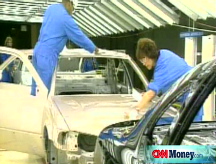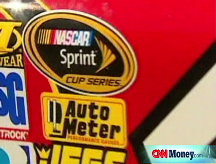4 questions for GM and Chrysler
If they want more money, the automakers need to give more details about cost cuts.
NEW YORK (CNNMoney.com) -- General Motors and Chrysler LLC will present their latest plans to the federal government Tuesday about how they will survive for the long-term.
The two companies have already received approval for $17.4 billion in loans from the government, money that most experts believe has kept the struggling automakers from bankruptcy.
If GM and Chrysler do not prove to the government that they can be viable in the future, the loans could be recalled. With that in mind, here is what people should be paying close attention to in the plans.
What concessions did they win from the UAW and creditors? GM (GM, Fortune 500) and Chrysler are required to include details of deals they reached with their unions and their creditors to further cut costs.
So far, the two companies have reached agreements with the United Auto Workers on some issues, such as the elimination of the so-called "jobs bank," which gives laid-off autoworkers the right to near full pay for the life of the contract. GM and Chrysler also announced new buyout offers to further cut their hourly work force.
But there have yet to be any details on bigger cost-saving deals, such as how to fund union-controlled trusts that cover tens of billions of dollars in future retiree health care costs. The fund was created as part of the 2007 labor deal between the UAW and Detroit's Big Three automakers.
The expectation was that the United Auto Workers union would agree to accept equity in GM and Chrysler for half of the assets to be placed in those funds. But the UAW walked away from the negotiating table late last week, reportedly when GM asked the union to take even more of its depressed stock.
There has also been little indication so far that debt holders have agreed to swap debt for equity in the companies. The loans call for the automakers to shed two-thirds of their unsecured debt.
While Chrysler has little unsecured debt, it is widely believed to be trying to reach deals with holders of its secured debt. GM is struggling under $35 billion of unsecured debt.
What other costs can GM and Chrysler cut? GM could announce a decision to discontinue several brands, such as Hummer, Saturn, Saab and even Pontiac. In December, when GM first asked Congress for financial assistance, the company said these brands were on the bubble.
GM also said in December that it may cut in the number of U.S. factories from 47 to 38 over the next four years. So a more detailed time table for those closings could be announced Tuesday.
Chrysler could also announce additional plant closing plans, as it discusses various options to partner with overseas automakers such as Nissan (NSANY) and Fiat.
The Wall Street Journal reported Saturday that GM also layout a bankruptcy option in its plan -- even though the company has repeatedly said it did not believe such a plan was workable.
According to the report, the government would provide so-called "debtor in possession" financing to fund GM's operations during a court supervised reorganization. The company would not comment on the report.
But a source familiar with GM's plans said that while the bankruptcy option will be discussed, GM will argue that the government financing needed to keep the company alive during bankruptcy would be many times greater than what it would cost to keep out of bankruptcy.
And that leads to the next question.
How much more money will GM and Chrysler ask for? In December, GM said it needed $18 billion to make it to 2010. Chrysler was asking for $7 billion.
But when Congress failed to pass the Detroit bailout, the Bush administration stepped in with stopgap loans of $13.4 billion for GM and $4 billion for Chrysler.
The companies would clearly like the full amount of money they asked for in December, given the weakening sales environment. The question is whether they will want more money on top of that.
Several experts believe it will take a lot more than $34 billion - a number that includes a $9 billion line of credit that Ford Motor (F, Fortune 500) requested in case conditions in the auto market deteriorated even more than expected - to save the U.S. automakers.
Mark Zandi, chief economist of Moody's Economy.com, testified before Congress in December that it would cost between $75 billion and $125 billion to bailout the Big Three.
What are their current sales forecasts? GM and Chrysler both gave 2009 sales forecasts in December that seemed grim at the time. But now, they appear to be optimistic.
GM's baseline forecast was for a seasonally adjusted annual sales rate, or SAAR, of about 11 million vehicles in the first quarter, on its way to 2009 industrywide sales just under 12 million. It forecast that sales would rebound to just under 15 million cars and light trucks by 2012.
But January sales were below a 10 million SAAR for the first time since 1982, and the early take on February sales show little improvement. GM announced in January it is now working with the assumption that full-year sales this year will be just over 10 million vehicles.
Chrysler's plans called for a more conservative 11.1 million SAAR in 2009. But its vice chairman Jim Press said earlier this month that industrywide sales may stay near 10 million for the next four years.
The terrible December and January sales have led to losses and production cuts even at formerly profitable Asian automakers such as Toyota Motor (TM) and Nissan. Nissan has announced 20,000 staff cuts worldwide. Toyota has stopped work on a nearly complete Mississippi plant that had been set to make a hybrid Prius on U.S. soil for the first time.
The weaker forecasts from these companies only raise more red flags for the U.S. automakers. Most experts believe it is impossible for GM and Chrysler to return to profitability if annual vehicle sales remain below 10 million for the foreseeable future. That means the price tag of a Detroit bailout is likely to climb much higher. ![]()





